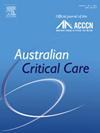N95 respirator seal integrity following extended-use by healthcare workers in the intensive care unit: A cohort study
IF 2.6
3区 医学
Q2 CRITICAL CARE MEDICINE
引用次数: 0
Abstract
Aim/objectives
Fit testing of N95/FFP2 respirators is universally recommended before exposure to airborne infectious diseases such as COVID-19. Respirator supply shortage in the COVID-19 pandemic encouraged extended-use for up to 4 h, despite uncertainty about seal integrity over time. The aim of our study was to assess N95 seal integrity after at least 2 h of continuous clinical use in the intensive care unit (ICU). We hypothesised that seal integrity would deteriorate over time, with variability between respirator shapes.
Methods
A prospective cohort study of healthcare workers in a metropolitan ICU setting in Australia between April 2021 and August 2022. Following consent and screening, participants underwent qualitative fit testing in the ICU, and fit tests were repeated following a continuous period of at least 2-h usage. The primary outcome was N95 fit-test failure rate measured by qualitative fit testing of >2 h compared to baseline. Secondary outcomes evaluated effects of respirator shape, demographic characteristics, and duration of respirator use on respirator fit after 2 h use.
Results
Fifty-one participants were recruited and consented. Six participants were excluded; four failed baseline fit test, one could not taste saccharin, and one did not complete 2 h of usage. Fourteen of 45 participants (∼31%) failed the extended-use fit test (median duration: 2 h 10 min [interquartile range: 2:07–2:20]). Fit-test rates differed between respirator shapes; three-piece flat-fold respirators had lower failure rates (6/32; 19%) than duckbill-shaped respirators (6/11; 55%) p = 0.046. No other demographic characteristic or respirator shape was significantly associated with increased failure rate.
Conclusions
Following 2 h of use, approximately 30% of participants failed repeat fit testing, suggesting incomplete respiratory protection. Three-piece flat-fold respirators outperformed duckbill respirators. Extended use of respirators, even without respirator reuse, may put healthcare workers at risk of inadequate respiratory protection, in particular when using duckbill-shaped respirators.
重症监护室医护人员长时间使用 N95 呼吸器后的密封完整性:一项队列研究。
目的/目标:在接触 COVID-19 等空气传播传染病之前,普遍建议对 N95/FFP2 呼吸器进行密合度测试。在 COVID-19 大流行中,呼吸器供应短缺促使人们延长使用时间长达 4 小时,尽管随着时间的推移密封完整性仍存在不确定性。我们研究的目的是评估在重症监护室(ICU)连续临床使用至少 2 小时后 N95 密封件的完整性。我们的假设是,密封完整性会随着时间的推移而恶化,不同形状的呼吸器之间存在差异:前瞻性队列研究:2021 年 4 月至 2022 年 8 月期间,对澳大利亚大都市 ICU 环境中的医护人员进行研究。在征得同意和筛选后,参与者在重症监护室进行了密合度定性测试,并在连续使用至少 2 小时后重复进行密合度测试。主要结果是与基线相比,N95密合度测试失败率(通过>2小时的定性密合度测试进行测量)。次要结果是评估呼吸器形状、人口统计学特征和呼吸器使用时间对使用 2 小时后呼吸器密合度的影响:共招募了 51 名参与者并征得其同意。结果:共招募了 51 名参与者并征得其同意,其中 6 人被排除在外;4 人未通过基线密合度测试,1 人无法品尝糖精,1 人未完成 2 小时的使用。45 名参与者中有 14 人(31%)未能通过延长使用时间的密合度测试(中位数时间:2 小时 10 分钟[四分位间范围:2:07-2:20])。不同形状呼吸器的密合度测试失败率不同;三片式平折呼吸器的失败率(6/32;19%)低于鸭嘴型呼吸器(6/11;55%),P = 0.046。其他人口特征或呼吸器形状均与故障率的增加无明显关联:使用 2 小时后,约 30% 的参与者未能通过重复密合度测试,这表明呼吸保护功能不完善。三片式平折叠呼吸器的性能优于鸭嘴式呼吸器。长时间使用呼吸器,即使没有重复使用呼吸器,也可能使医护人员面临呼吸保护不足的风险,尤其是在使用鸭嘴型呼吸器时。
本文章由计算机程序翻译,如有差异,请以英文原文为准。
求助全文
约1分钟内获得全文
求助全文
来源期刊

Australian Critical Care
NURSING-NURSING
CiteScore
4.90
自引率
9.10%
发文量
148
审稿时长
>12 weeks
期刊介绍:
Australian Critical Care is the official journal of the Australian College of Critical Care Nurses (ACCCN). It is a bi-monthly peer-reviewed journal, providing clinically relevant research, reviews and articles of interest to the critical care community. Australian Critical Care publishes peer-reviewed scholarly papers that report research findings, research-based reviews, discussion papers and commentaries which are of interest to an international readership of critical care practitioners, educators, administrators and researchers. Interprofessional articles are welcomed.
 求助内容:
求助内容: 应助结果提醒方式:
应助结果提醒方式:


